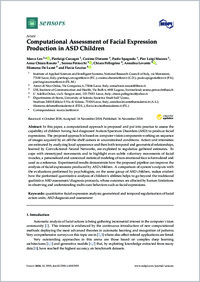Computational assessment of facial expression production in ASD children
- Leo, Marco Institute of Applied Sciences and Intelligent Systems, National Research Council of Italy, via Monteroni, 73100 Lecce, Italy
- Carcagnì, Pierluigi Institute of Applied Sciences and Intelligent Systems, National Research Council of Italy, via Monteroni, 73100 Lecce, Italy
- Distante, Cosimo Institute of Applied Sciences and Intelligent Systems, National Research Council of Italy, via Monteroni, 73100 Lecce, Italy
- Spagnolo, Paolo Institute of Applied Sciences and Intelligent Systems, National Research Council of Italy, via Monteroni, 73100 Lecce, Italy
- Mazzeo, Pier Luigi Institute of Applied Sciences and Intelligent Systems, National Research Council of Italy, via Monteroni, 73100 Lecce, Italy
- Rosato, Anna Chiara Amici di Nico Onlus, Via Campania, 6, 73046 Lecce, Italy
- Petrocchi, Serena Institute of Communication and Health (ICH), Facoltà di scienze della comunicazione, Università della Svizzera italiana, Svizzera
- Pellegrino, Chiara L’Adelfia Onlus, via S. Sangiovanni, 115-73031 Lecce, Italy
- Levante, Annalisa Dipartimento di Storia, University of Salento, Società e Studi Sull’ Uomo, Studium 2000-Edificio 5-Via di Valesio, 73100 Lecce, Italy
- De Lumè, Filomena Dipartimento di Storia, University of Salento, Società e Studi Sull’ Uomo, Studium 2000-Edificio 5-Via di Valesio, 73100 Lecce, Italy
- Lecciso, Flavia Dipartimento di Storia, University of Salento, Società e Studi Sull’ Uomo, Studium 2000-Edificio 5-Via di Valesio, 73100 Lecce, Italy
-
16.11.2018
Published in:
- Sensors. - 2018, vol. 18, no. 11, p. 3993
Quantitative facial expression analysis
Geometrical and temporal regularization of facial action units
ASD diagnosis and assessment
English
In this paper, a computational approach is proposed and put into practice to assess the capability of children having had diagnosed Autism Spectrum Disorders (ASD) to produce facial expressions. The proposed approach is based on computer vision components working on sequence of images acquired by an off-the-shelf camera in unconstrained conditions. Action unit intensities are estimated by analyzing local appearance and then both temporal and geometrical relationships, learned by Convolutional Neural Networks, are exploited to regularize gathered estimates. To cope with stereotyped movements and to highlight even subtle voluntary movements of facial muscles, a personalized and contextual statistical modeling of non-emotional face is formulated and used as a reference. Experimental results demonstrate how the proposed pipeline can improve the analysis of facial expressions produced by ASD children. A comparison of system’s outputs with the evaluations performed by psychologists, on the same group of ASD children, makes evident how the performed quantitative analysis of children’s abilities helps to go beyond the traditional qualitative ASD assessment/diagnosis protocols, whose outcomes are affected by human limitations in observing and understanding multi-cues behaviors such as facial expressions.
- Language
-
- English
- Classification
- Medicine
- License
- Open access status
- gold
- Identifiers
-
- RERO DOC 328296
- DOI 10.3390/s18113993
- ARK ark:/12658/srd1318990
- Persistent URL
- https://n2t.net/ark:/12658/srd1318990
Statistics
Document views: 213
File downloads:
- Texte intégral: 325
